After tasting wines in the hotel with the producers for two days, it was nice to get out and visit the wineries and walk among the vines. We also visited a cheese producer, the octagonal castle commissioned by the Emperor Frederick II of Swabia, and the region around the castle known as Castel del Monte.

Castel del Monte
The Santa Lucia Winery
We were guided in our walking tour of the vineyards by Robert Perrone Capano, one of the owners. He pointed out the different training systems for the vines, the Guyot and the more traditional Tendone system (Pergola). They do not buy grapes, do not use any chemical products in the fields, and are 100% biological. Grass was growing between the rows of vines and Robert told us that this was done so that they would have natural mulch after the grass was cut and that the competition with the grass for “food” and water was good for the vines.

Santa Lucia Winery
They use French oak barriques (Allier and Troncais). Fined grained 228L barrels but he said it is a very “controlled” use as well as 35hl barrels. For their top wines there is no stabilization or filtration. All this they feel gives them their individuality and a respect for the terroir.
We then had a tasting of Riserva “Le More” Castel Del Monte DOC 2007, 2006, 2004, 2003, 2001, 2000, 1999, 1998 and1996.
I have tasted older vintages of Negroamaro and Primitivo but most of the Nero di Troia I tasted were from recent vintages. I have had older Nero di Troia, but those wines from the Castel Del Monte always had a fair percentage of Montepulciano. I was looking forward to this tasting so many different vintages of Uva di Troia (also know as Nero di Troia) at one tasting.

The Tendone system at Santa Lucia
Uva di Troia grows best in the Castel del Monte zone, an area that extends north from Bari to the province of Foggia. This area was once dominated by Frederick ll of Swabia (Hohenstaufen, d.1250). He was called “the wonder of the world” by some and “the antichrist” by the pope, and he left his imprint on this part of Puglia.
Uva di Troia might have originated in Asia Minor and was probably brought here by the Greeks. It is named for the town Troia (Troy) in the province of Foggia. The grape does very well in Puglia’s hot climate and does well in most soils. The clusters are compact, V-shaped and sometimes winged and the grapes are violet in color. Uva di Troia ripens in the middle of October later than most other grapes in this region.
Roberto led us in a tasting of his Uva di Troia
2007 is 100% Uva di Troia. There are 4,000/5000 plants/ha trained in single and double Guyot. The grapes are harvested in mid to late October, they are softly pressed and maceration takes place in rotating stainless steel tanks. It is aged for 12/18 months in French barriques of 228L and in bottle for twelve months before release. This is a more modern style wine. This is the current vintage.
Here are some of my comments on the wines:
1996 was a very interesting wine. The vineyard was 50 years old and it was owned by the owner’s aunt who died at the age of 97. It was aged in 35hl barrels. The wine was still very much alive with very good color. It still had fruit and was drinking very well. I drank all of it with the light lunch that we were served.
1998 was very much like the 1996 but not as mellow.
1999 was very also drinking very well with nice mature fruit and a hint of chocolate. I drank all of this wine.
2000 was not drinking as well as the older wines but was still holding up.
2001–with this vintage it seemed to me that they went to a more modern style
and I felt the wine had changed.
2004 was a good vintage–this was drinking well and was the best of the modern style wines.
They are also doing a top of the line wine called Riserva 0,618 Castle del Monte DOC.
100% Uva di Troia . Only 500 bottles will be produced. After being aged for 18 months in 225 liter oak barrels the wine matures underground for 6-1/2 years. It will be released it 2012. 0,168 a numerical sequence called “Golden Means” in medieval times and was developed by Fibonacci, a mathematician from Pisa in the Xll century. The famous octagonal Castel del Monte designed with this formula and commissioned by Frederic ll, is only 20Kl from the vineyards and can be seen on clear days.
Next we visited Villa Schinosa, a winery that I had visited a few years ago. I had been impressed by their wines. When I walked into the wine cellar I was happy to see that everything was the same. Two long rows of barrels of Slovenian oak 35HL and not a barrique in sight. Another winery we visited had a large room filled with many new barriques. After a few minutes I had to leave because the smell was making me ill. At Villa Schinosa all the wines are aged in stainless steel or in botte grande.
I like their 100% Uva di Troia 2007 DOC. The wine is aged for two years in large barrels of Slavonian oak 35HL and for 3/6 months in bottle before release. It is a very elegant wine with black fruit aromas and flavors and hints of violet with a very pleasant finish and aftertaste. It is a very good food wine.
The Botromagno winery is located just outside the town of Gravina. In 1991 the D’Agostino family, which was a member of the local cooperative took it over. It was the first time in Italy where a privately owned compan partnered with more than 100 local growers. We were given a tour of the winery by the very personable and knowledgeable Beniamino D’Agostino. I had met Beniamino before when I was working for an Apulian restaurant in NYC where we sold his wines, and at Vintaly in Verona.
Gravina DOC 2009 made from 60% Greco di Tufo and 40% Malvasia. Beniamino said that sometime there is the addition of a little Fiano and Bianco di Alessano. Fermentation is in stainless steel tanks for 15 days, there is no malolatic. The wine is fruity and fresh almost like biting into a green apply with a slight touch of pineapple and good acidity. They are the only producers of Gravina.
Pier della Vigno Rosso Murgia IGT 2006 Made from 60% Aglianico and 40% Montepulciano The vines of Aglianico are planted in deep volcanic soil and the ones for Montepulciano in chalky soil. The training system is also different, bush for Aglianico and vertical for Montepulciano. The harvest takes place in late October. The wine is fermented in stainless steel with 20 days skin contact. 50% of the wine is in new Allier barriques and 50% in barriques of second passage. The wine has aromas and flavors of red berries, pepper, and hints of tobacco and chocolate.
The wine is named for Pier della Vigno the right hand man of Frederic II of Swabia. Pier was said to introduce the first red grapes to this zone.
I also liked their Nero di Troia Rosso Murgia IGT 2007. Fermentation takes place in stainless steel tanks with skin contact for 10 days. The wine is then aged in stainless steel for 20 months. The wine does not undergo malolatic fermentation. It remains in the bottle for six months before release. This is a very interesting wine with aromas and flavors of cherries, tobacco and a touch of spice.
On the afternoon of the last day there was a vertical tasting of Taurasi (Aglicanico), Contrade di Taurasi Cantina Leonardo and Patriglione (90% Negroamaro and 10% Malvasia Nera) Cosimo Taurino Vintages 99-00-01 the panel was hosted by Franco Ziliani and Luciano Pignataro.
I have a long history with Patriglione going back to the first vintage in 1979. It had been called the Amarone of the south–a description I never liked. I visited the winery a few years ago and tasted the ‘99. I also tasted it a number of times in NYC. I found the wine not to be as big and jammy as some of the older vintages. It is still a powerful wine but more elegant and the dried fruit was not as pronounced. However there is still the classic Negroamaro aroma with an undertone of prune. The 2000 and 2001 had the same characteristic. When I asked Francesco Taurino if he did anything different since 1999, his answer was “only in the vineyard”. My favorite at the tasting was the 2001. At a League of Gentle Men dinner I brought the 1999 Patrigione and I decanted it before dinner. The wine opened in the glass and was really drinking well.
Cantina Leonardo Contrade di Taurasi 100% Aglianico this winery is only four hectares of vineyards and produces only four wines. The vineyards are at 350/400 meters and the vines are 20/50 years old. The harvest takes place the first week of November. Maceration in stainless steel for one month, aged in barrels for 18 months and in bottle for 12 months before it is released. The wine has aromas and flavors of cherry, plum, violets and hints of spice. The 2001 was showing the best.
In the evening of the last day there was a presentation of three books written about wine, food and places to stay in Puglia. They are:
Pizzaviaggiando The first edition of a guide by Nicola Campanile on Apulian pizzerias
Dolce Guide – Percorsi enogastronomici di Puglia e dintorni a guide to the restaurants, wine bars and places to stay in Apulia (Eighth Edition). Food and wine tours in Puglia and the surrounding area by Vincenzo Rizza and Nicholas Bell.
Radici wines: Guide on Apulian wines for experts and wine lovers 2011 (second edition). Based on an idea by Nicola Campanile, who is also the editor. Texts by Franco Zilliani (wine professional) and Vincenzo Rizzi (wine lover) English Texts by Kyle Phillips. The wines in this book were chosen by two panels one made up of wine professionals called, The technical jury and one made up on non-professionals called The wine lovers jury. The book contains reviews of 178 wines competing for the top awards that were given out the last day of the Radici Experience. All the wines in the competition are from the indigenous grapes of Puglia.
For more information on The Radici Puglia Experience go to www.vinidiradici.com
There is an interesting article by Nicola Campanile president of ProPapilla titled “Southern Roots and good reason to think big”. If you sign up on the site you can find the 35 wines that took top honors as well as the other awards that were given out.
Valerie’s New York www.wor710 listen to Charles Scicolone On Wine every Wednesday at 6:05.
www.loveofpizzatour.com – pizza and more!
 Recently, Maureen and her husband Franco Filippi invited Michele and I and a group of friends for lunch in her apartment overlooking the Colosseum in Rome.
Recently, Maureen and her husband Franco Filippi invited Michele and I and a group of friends for lunch in her apartment overlooking the Colosseum in Rome. Maureen (second left), Franco (far right), and some of the guests sipping welcome glasses of Ca’del Bosco spumante before the antipasto which included fresh cheeses, marinated carrots, dried tomatoes, olives, marinated anchovies, and many other savory bites.
Maureen (second left), Franco (far right), and some of the guests sipping welcome glasses of Ca’del Bosco spumante before the antipasto which included fresh cheeses, marinated carrots, dried tomatoes, olives, marinated anchovies, and many other savory bites.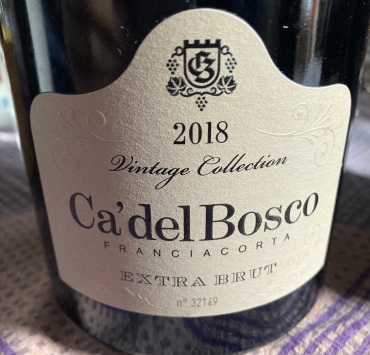 Franciacorta DOCG Extra Brut 2018 Vintage Collection Ca’ del Bosco (Lombardia) made from 65% Chardonnay, 5% Pinot Bianco and 30% Pinot Nero from 27 certified organic vineyards. Grapes are hand harvested and each individual bunch is washed and dried. Fermentation takes place for 5 months in oak barrels. The wine remains on the yeasts for an average of 48 months. This is an elegant wine with hints of citrus fruit, apple and pear lemon and a touch of pineapple. One of my favorites.
Franciacorta DOCG Extra Brut 2018 Vintage Collection Ca’ del Bosco (Lombardia) made from 65% Chardonnay, 5% Pinot Bianco and 30% Pinot Nero from 27 certified organic vineyards. Grapes are hand harvested and each individual bunch is washed and dried. Fermentation takes place for 5 months in oak barrels. The wine remains on the yeasts for an average of 48 months. This is an elegant wine with hints of citrus fruit, apple and pear lemon and a touch of pineapple. One of my favorites. Vino Spumante Brut Metodo Classico Stefanini (Lazio) made from 100% Rossetto. White wine vinification with selected yeasts in steel tanks at a controlled temperature. Malolactic fermentation does not take place. The wine spends 24 months on the lees. This was a first for me. I did not know the wine or the producer. It is a full bodied spumante with hints of citrus fruit, floral notes, a touch of almonds and nice minerality.
Vino Spumante Brut Metodo Classico Stefanini (Lazio) made from 100% Rossetto. White wine vinification with selected yeasts in steel tanks at a controlled temperature. Malolactic fermentation does not take place. The wine spends 24 months on the lees. This was a first for me. I did not know the wine or the producer. It is a full bodied spumante with hints of citrus fruit, floral notes, a touch of almonds and nice minerality. Garganelli con sugo di cipolle — pasta with onion sauce
Garganelli con sugo di cipolle — pasta with onion sauce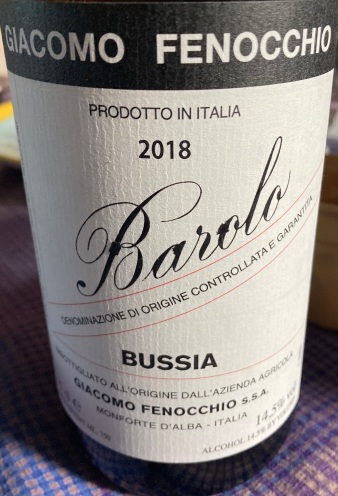 Barolo Bussia Giacomo Fenocchio 2018 100% Nebbiolo varieties Michet and Lampia. Monforte d’Alba-Sottozone Bussia (Piemonte). From a 5 hectare vineyard facing south/southwest at 300 meters. The soil is Helvetian with clayey and calcareous sediments, rich in iron. The vines are 30 years old. Traditional natural fermentation without added yeasts for 40 days in stainless steel tanks. The wine ages for 6 months in stainless steel tanks and 30 months in large Slavonian casks 35 to 50 hl. It remains in the bottle a time before release. This is a classic Barolo with hints of spice, licorice, roses, tar and tea. I visited the winery a few years ago and have always enjoyed their wines.
Barolo Bussia Giacomo Fenocchio 2018 100% Nebbiolo varieties Michet and Lampia. Monforte d’Alba-Sottozone Bussia (Piemonte). From a 5 hectare vineyard facing south/southwest at 300 meters. The soil is Helvetian with clayey and calcareous sediments, rich in iron. The vines are 30 years old. Traditional natural fermentation without added yeasts for 40 days in stainless steel tanks. The wine ages for 6 months in stainless steel tanks and 30 months in large Slavonian casks 35 to 50 hl. It remains in the bottle a time before release. This is a classic Barolo with hints of spice, licorice, roses, tar and tea. I visited the winery a few years ago and have always enjoyed their wines.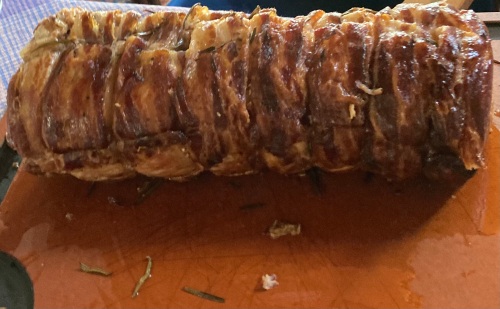 Roasted Pork Loin with Pancetta and Herbs
Roasted Pork Loin with Pancetta and Herbs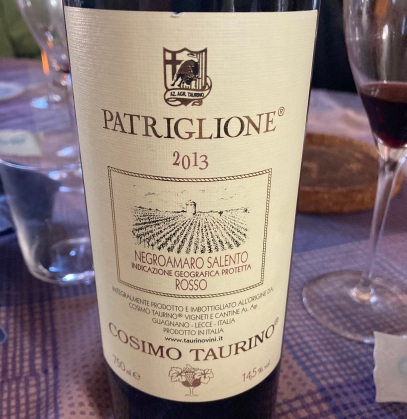 Negroamaro Salento IGP Rosso 2013 “Patriglione” Cosimo Taurino made from 100% Negramaro from 40 to 50 year old vines. The vineyard is 15 hectares with a east/west exposure, flat elevation and the soil is calcareous. There are 6,000 plants per hectare and the training system is spurred Apulian small trees. The grapes are picked late the second week of October. The fermentation tanks are vitrified concrete and there is an automatic cooling system. Fermentation is for 10/15 days with 8/12 days skin contact.This is a wine that will age for many years. It has hints of dry black fruit, blackberries blueberries, prune and raisins. I have been drinking the wines from Cosimo Taurino for many years.
Negroamaro Salento IGP Rosso 2013 “Patriglione” Cosimo Taurino made from 100% Negramaro from 40 to 50 year old vines. The vineyard is 15 hectares with a east/west exposure, flat elevation and the soil is calcareous. There are 6,000 plants per hectare and the training system is spurred Apulian small trees. The grapes are picked late the second week of October. The fermentation tanks are vitrified concrete and there is an automatic cooling system. Fermentation is for 10/15 days with 8/12 days skin contact.This is a wine that will age for many years. It has hints of dry black fruit, blackberries blueberries, prune and raisins. I have been drinking the wines from Cosimo Taurino for many years. On the plate. Roast pork loin, mashed potatoes, braised artichokes and pearl onions agrodolce.
On the plate. Roast pork loin, mashed potatoes, braised artichokes and pearl onions agrodolce. Our dessert was made by another guest, Susan Westmoreland.
Our dessert was made by another guest, Susan Westmoreland. It was a rich and spicy ginger cake served with braised apples and whipped cream.
It was a rich and spicy ginger cake served with braised apples and whipped cream.
 These included events at the Italian Consulate, The Fancy Food Show, an event on a boat, and the last a wine tasting and lunch at
These included events at the Italian Consulate, The Fancy Food Show, an event on a boat, and the last a wine tasting and lunch at  “Sissy Pop” Extra Brut Classic Method Masseria del Sole (Foggia) made from 100% Nero di Troia. The soil is clay/calcareous. There is a manual harvest and fermentation is in steel tanks at a controlled temperature. The wine has hints of dried almonds, hazelnut, blood orange, plum and fig.
“Sissy Pop” Extra Brut Classic Method Masseria del Sole (Foggia) made from 100% Nero di Troia. The soil is clay/calcareous. There is a manual harvest and fermentation is in steel tanks at a controlled temperature. The wine has hints of dried almonds, hazelnut, blood orange, plum and fig. Puglia IGT Rosato BIO “Tre Tomoli Rosa” Vigna Flora (Bari) made from 100% Susumaniello. The soil is loamy and clayey. There is a manual harvest of the grapes followed by destemming and a soft crushing. Maceration in contact with the skin for 3 to 5 hours to get a peachy-pink color. Fermentation takes place at a controlled temperature for 15 days. Malolactic fermentation is not carried out. The wine remains in steel and bottle for 15 days before release. The wine has hints of white peach, pink grapefruit and citrus tones.
Puglia IGT Rosato BIO “Tre Tomoli Rosa” Vigna Flora (Bari) made from 100% Susumaniello. The soil is loamy and clayey. There is a manual harvest of the grapes followed by destemming and a soft crushing. Maceration in contact with the skin for 3 to 5 hours to get a peachy-pink color. Fermentation takes place at a controlled temperature for 15 days. Malolactic fermentation is not carried out. The wine remains in steel and bottle for 15 days before release. The wine has hints of white peach, pink grapefruit and citrus tones. Primitivo di Manduria DOC “Lirica” 2017 Produttori di Manduria Manduria. Made from 100% Primitivo. The soil is of a medium texture with calcareous tufa. Red wine vinification with thermo-conditioning of the fermentation process. The wine is in contact with the skins for 1 week and is aged for a minimum of 6 months in large barrels. This is an intense and elegant wine with hints of dark fruit, cherry, plum a hint of spice and a touch of ginger. This was a very impressive Primitivo.
Primitivo di Manduria DOC “Lirica” 2017 Produttori di Manduria Manduria. Made from 100% Primitivo. The soil is of a medium texture with calcareous tufa. Red wine vinification with thermo-conditioning of the fermentation process. The wine is in contact with the skins for 1 week and is aged for a minimum of 6 months in large barrels. This is an intense and elegant wine with hints of dark fruit, cherry, plum a hint of spice and a touch of ginger. This was a very impressive Primitivo. Primitivo di Manduria DOC “Raccontami” Vespa Vignaioli (Manduria) made from 100% Primitivo. The soil is limestone-clayey. The skins fermentation is for 15 days, malolactic fermentation is in barriques and and the wine is aged for 12 months in barrel. The wine has hints of black and red fruits, with a touch of tobacco and a hint of vanilla.
Primitivo di Manduria DOC “Raccontami” Vespa Vignaioli (Manduria) made from 100% Primitivo. The soil is limestone-clayey. The skins fermentation is for 15 days, malolactic fermentation is in barriques and and the wine is aged for 12 months in barrel. The wine has hints of black and red fruits, with a touch of tobacco and a hint of vanilla.
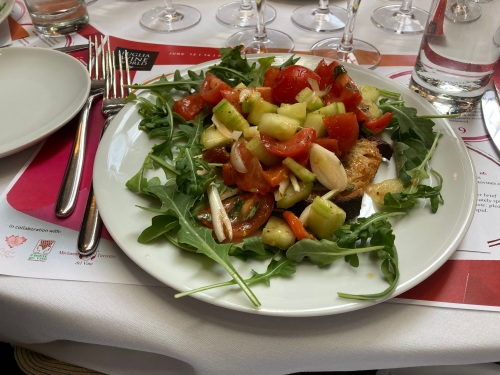 For lunch we began with a refreshing salad Acquasale Di Frisella, Cipolle, Cetriolini E Peperoni. Toasted bread with onions, cucumbers and bell peppers.
For lunch we began with a refreshing salad Acquasale Di Frisella, Cipolle, Cetriolini E Peperoni. Toasted bread with onions, cucumbers and bell peppers. Tiella Pugliese Tradizionale Di Riso, Patate E Cozze is a typical Pugliese casserole with rice, potatoes and mussels.
Tiella Pugliese Tradizionale Di Riso, Patate E Cozze is a typical Pugliese casserole with rice, potatoes and mussels. Rose — Botromagno is one of my favorite producers in Puglia
Rose — Botromagno is one of my favorite producers in Puglia
 Agnello Al Sugo Alla Salentina Con Patate was a savory lamb stew with potatoes to go with the red wines.
Agnello Al Sugo Alla Salentina Con Patate was a savory lamb stew with potatoes to go with the red wines.
 Red Wine #3 SoliAir is an importer and distributor that carries an excellent line of wines.
Red Wine #3 SoliAir is an importer and distributor that carries an excellent line of wines. Dolce Torta Di Albicocche Con Salsa Al Cioccolato E Mandorle Tostate is a delicate almond cake with apricots and chocolate sauce.
Dolce Torta Di Albicocche Con Salsa Al Cioccolato E Mandorle Tostate is a delicate almond cake with apricots and chocolate sauce.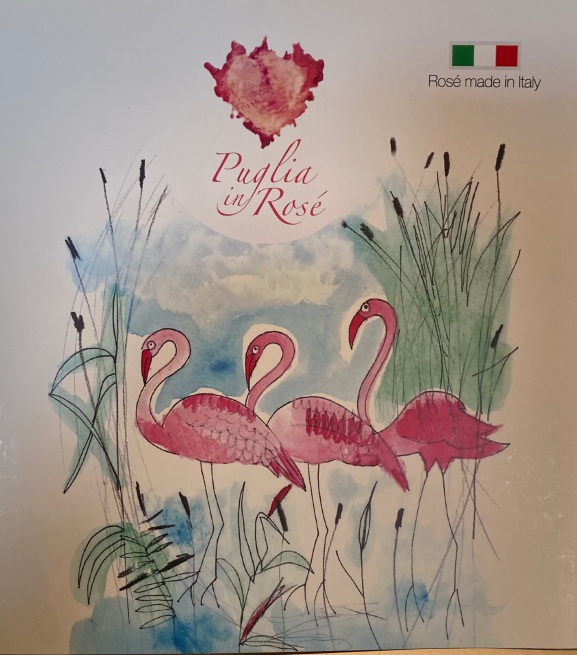
 Puglia Rosato IGP “Maglida” 2020 Cantine Barsento made from Malvasia and Negroamaro. The soil is clay and limestone.There is are selection of the grapes at harvest. Fermentation takes place at a low temperature in stainless steel tanks.
Puglia Rosato IGP “Maglida” 2020 Cantine Barsento made from Malvasia and Negroamaro. The soil is clay and limestone.There is are selection of the grapes at harvest. Fermentation takes place at a low temperature in stainless steel tanks. Puglia Rosato IGP Selva della
Puglia Rosato IGP Selva della Puglia Rosé IGP “Forme” 2021 Cantine Massimo Leone. Made from 100% Nero di Troia. The soil is Karstic and clayey. Fermentation takes place at a controlled temperature and skin contact is for 8 hours. Pink in color with coral reflections with hints of black fruit, red roses and a touch of spice. Caterina
Puglia Rosé IGP “Forme” 2021 Cantine Massimo Leone. Made from 100% Nero di Troia. The soil is Karstic and clayey. Fermentation takes place at a controlled temperature and skin contact is for 8 hours. Pink in color with coral reflections with hints of black fruit, red roses and a touch of spice. Caterina Rosato IGP “Cattedrale”
Rosato IGP “Cattedrale” Puglia Primitivo IGP “Soffio”
Puglia Primitivo IGP “Soffio” Puglia Primitivo IGP
Puglia Primitivo IGP Puglia in Rosé
Puglia in Rosé 


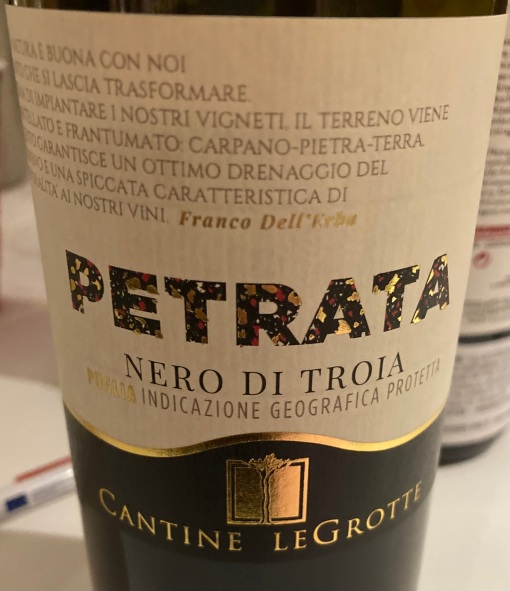 Nero di Troia IGP “Petrata” Made from 100% Nero Di Troia. Temperature controlled maturation in stainless steel. The wine has black fruit aromas and flavors with hints of blackberry and blueberry.
Nero di Troia IGP “Petrata” Made from 100% Nero Di Troia. Temperature controlled maturation in stainless steel. The wine has black fruit aromas and flavors with hints of blackberry and blueberry.
 Murgia Rosè IGT made from Bambino Nero and Malvasia Nera. Fermentation is in temperature controlled steel tanks. The wine has hints of red fruit, raspberry and strawberry and a note of spice.
Murgia Rosè IGT made from Bambino Nero and Malvasia Nera. Fermentation is in temperature controlled steel tanks. The wine has hints of red fruit, raspberry and strawberry and a note of spice. Primitivo Gloria Del Colle Riserva “Fanova” made from 100% Primitive from the Castellana Grotte and Acquaviva Delle Fonti area. The training system is the Apulian goblet. The vines are at 33/350 meters. Harvest takes place the third week of September. Fermentation is in steel tanks at a controlled temperature for 15/20 days. Aging in big French durhast barrels for about 12 months and another 12 months in bottle before release. This is a wine with hints of sour cherry, blackberry, prunes and a touch of spice.
Primitivo Gloria Del Colle Riserva “Fanova” made from 100% Primitive from the Castellana Grotte and Acquaviva Delle Fonti area. The training system is the Apulian goblet. The vines are at 33/350 meters. Harvest takes place the third week of September. Fermentation is in steel tanks at a controlled temperature for 15/20 days. Aging in big French durhast barrels for about 12 months and another 12 months in bottle before release. This is a wine with hints of sour cherry, blackberry, prunes and a touch of spice.





































